How to Grow Tomatoes: Complete Guide from Seed to Harvest
Growing your own tomatoes is one of the most rewarding gardening experiences. This comprehensive guide covers everything from choosing the right varieties to harvesting sun-ripened fruits, helping you grow delicious homegrown tomatoes whether you're a beginner or experienced gardener.
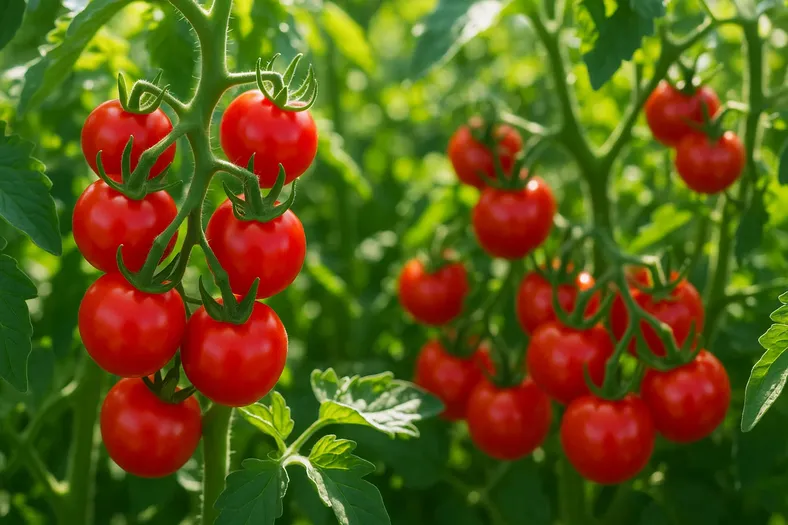
Tomatoes are one of the most popular crops to grow, offering gardeners the unmatched pleasure of eating sun-warmed, freshly picked fruits straight from the vine. Whether you're growing cherry tomatoes for snacking or large beefsteaks for slicing, homegrown tomatoes deliver flavors and varieties far beyond what's available in supermarkets.
These tender plants can be started from seed indoors or bought as young plants, then grown either outdoors or in a greenhouse, in pots or in the ground. While tomatoes do need some attention to grow well, including protection from frost and regular watering and feeding, they're well worth the effort when you can enjoy your own harvest all summer long.
Getting Started
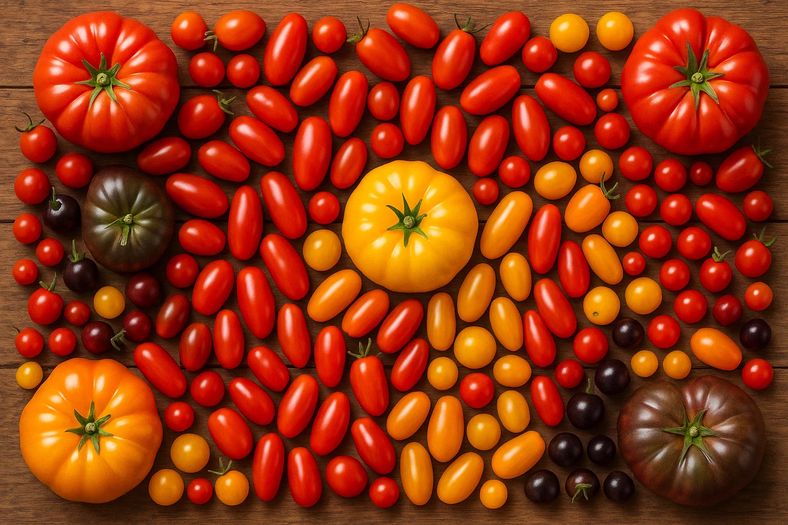
Cherry tomatoes are sweet and delicious, especially when harvested from your own plants. Tomatoes grow particularly well in a greenhouse, usually producing an earlier and larger crop, but when grown outdoors, these tender plants need a warm, sunny, sheltered site.
Botanically known as Solanum lycopersicum, tomatoes are closely related to potatoes and are similarly susceptible to blight disease outdoors, but rarely in a greenhouse.
There's an enormous range of varieties to choose from, offering fruits of different sizes, colors, textures, and flavors. Plant types vary from tall and vigorous cordon varieties to more compact bush types, as well as dwarf varieties for small containers and trailing plants for hanging baskets.
Growing Calendar
- Sow seeds: February - May
- Plant out: May - June
- Harvest: July - September
Choosing
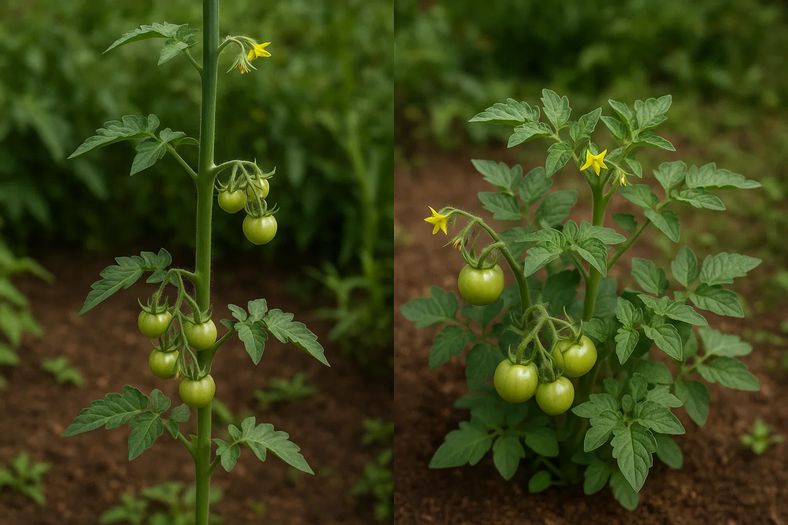
Tomatoes generally have two different ways of growing:
- Cordon (or indeterminate) tomatoes: Vigorous, fast-growing plants that get very tall and need suitable supports. They grow vertically, taking up little ground space, but need regular maintenance including watering, feeding, tying to supports, and removing side-shoots.
- Bush (or determinate) tomatoes: Naturally more compact plants, great for smaller spaces. Trailing types can be grown in windowboxes and hanging baskets. These are the easiest type to grow and need little maintenance apart from watering and feeding.
There are also numerous tomato varieties offering fruits of various sizes, shapes, flavors, and sweetness levels. Fruit colors range from traditional red to dark purple, pink, orange, yellow, green, and even striped varieties.
Recommended Varieties
- 'Brandy Boy': Beefsteak type with large, pink, thin-skinned fruits and rich flavor (Cordon)
- 'Costoluto Fiorentino': Deep-red, ribbed, early maturing beefsteak variety for greenhouse (Cordon)
- 'Cristal': Early, reliable salad variety with disease resistance (Cordon)
Sowing

Tomatoes are easy to grow from seed indoors. Timing depends on your growing location:
- Greenhouse growing: Sow from late February to mid-March
- Outdoor growing: Sow from late March to early April
Seeds need a temperature of about 18°C (64°F) to germinate, so use a heated propagator or place pots on a warm windowsill and cover with clear plastic to maintain humidity.
Seedlings usually appear within a fortnight. As soon as they emerge, uncover and place in as much light as possible to prevent them growing thin and leggy.
Pricking Out and Potting On
After a couple of weeks, once seedlings have developed true leaves, move them into individual pots or modules of peat-free multi-purpose compost. Handle seedlings carefully:
- Lift each seedling individually using a dibber to support the rootball
- Hold by a leaf rather than the delicate stem
- If the seedling is leggy, replant more deeply so the first pair of leaves is just above the compost surface
Keep in bright conditions with temperatures of at least 16°C (60°F) and water regularly. After about a month, they should be ready for their final position.
Planting
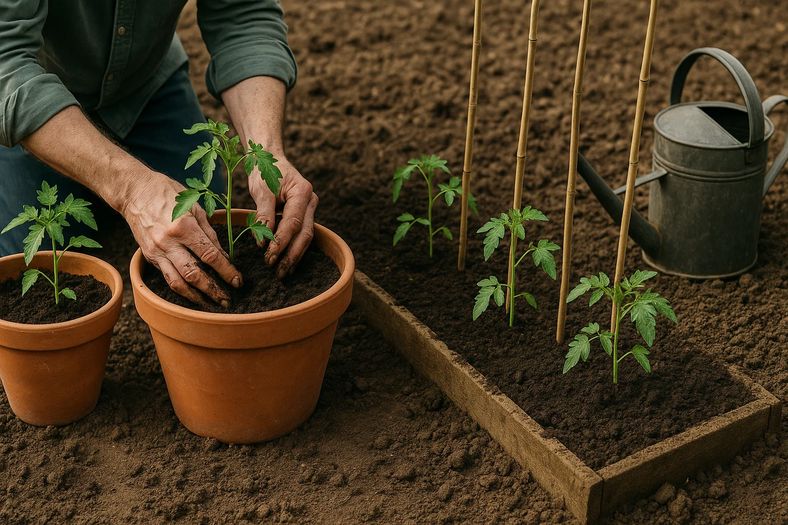
Young tomato plants can be planted into their final position in early summer, once temperatures are reliably above 16°C (60°F). Plant tomatoes deeply so the first set of leaves is just above the soil surface – the buried section of stem will produce additional roots.
Before planting outdoors, acclimatize plants to garden conditions by hardening off.
Planting in Containers
Pots or growing bags are ideal for tomatoes, whether in a greenhouse or outdoors in full sun:
- Use peat-free loam-based or multi-purpose compost
- Plant one tomato in a 30-45cm (12-18in) pot
- Plant two tomatoes in a standard growing bag
- Bush types are ideal for patio containers, troughs, and hanging baskets
- Cordon types need tall cane support in large containers
Planting in the Ground
Tomatoes thrive in rich, free-draining but moisture-retentive soil:
- Add plenty of garden compost before planting
- Choose your warmest, sunniest spot, sheltered from wind
- Space plants 45-60cm (18-24in) apart
- Insert sturdy canes next to cordon tomatoes and tie in the main stem
- Avoid growing tomatoes in the same bed in consecutive years
Plant Care
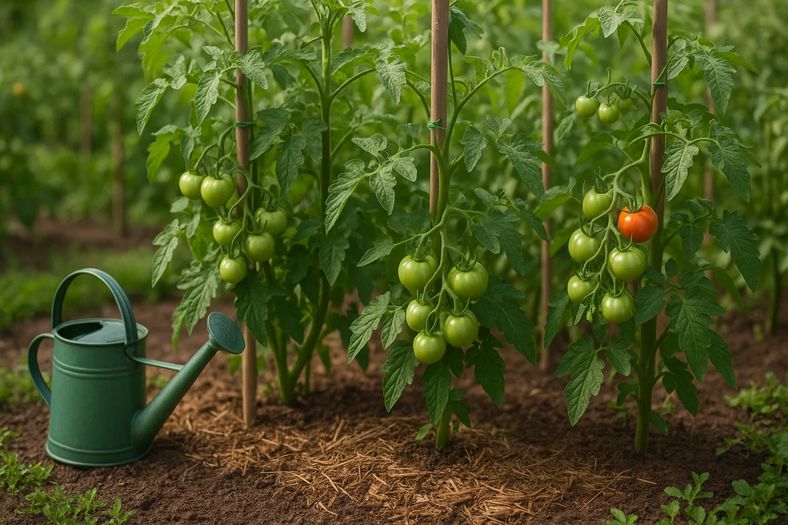
Watering
Water tomato plants regularly to keep the soil or compost evenly moist. Fluctuating moisture levels can cause fruit problems such as splitting or blossom end rot. Plants in containers dry out quickly and may need daily watering in hot weather.
Top tip: Sink a 15cm (6in) pot into the ground alongside tomato plants and water into it, directing water straight to the roots without moisture sitting around the plant neck.
Feeding
To boost fruiting, especially with container plants, feed every 10-14 days with high potassium liquid fertilizer once the first fruits start to swell.
Mulching
Apply a thick layer of mulch around tomato plants to:
- Help retain moisture
- Suppress weeds
- Use garden compost or well-rotted manure
- Leave a gap around the stem base to prevent rotting
Improving Pollination
When growing in a greenhouse:
- Open vents regularly for pollinating insect access
- Lightly tap or shake flowers when fully open
- Mist flowers with water to aid pollen transfer
Pruning and Training
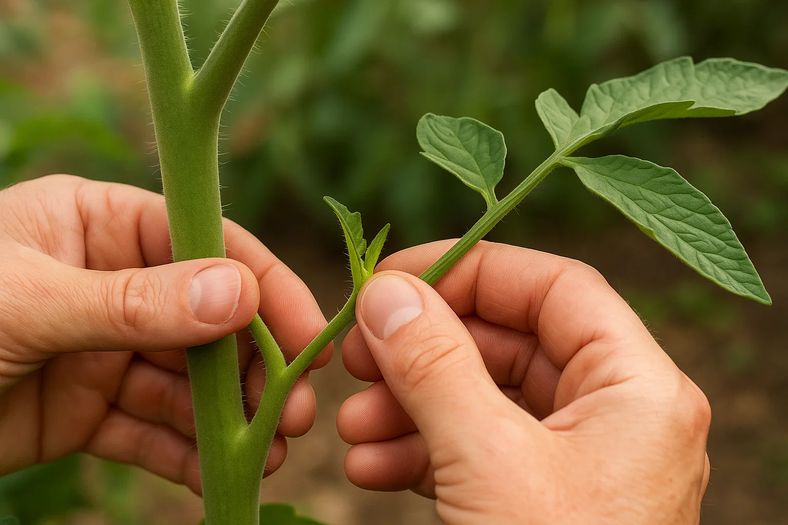
The two tomato types require different treatment:
Cordon Tomatoes
Grown as tall, single-stemmed plants requiring regular maintenance:
- Support: Use tall sturdy canes or vertical strings from overhead supports
- Tying: Attach main stem to cane at regular intervals, or wind string around stem weekly
- Side-shoot removal: Remove shoots sprouting from joints between leaves and main stem
- Stopping: When plants reach support top or have 7 fruit trusses (indoors) or 4 trusses (outdoors), remove the growing point two leaves above the top truss
Bush Tomatoes
More compact plants requiring minimal training:
- Leave side-shoots to grow naturally
- Provide support if plants become large or heavily laden
- Add short vertical canes where needed
Removing Side-shoots
For cordon tomatoes, check regularly for shoots sprouting above each leaf. Simply pinch out or snap off these side-shoots to maintain single-stem growth and concentrate energy into fruit production.
Harvesting
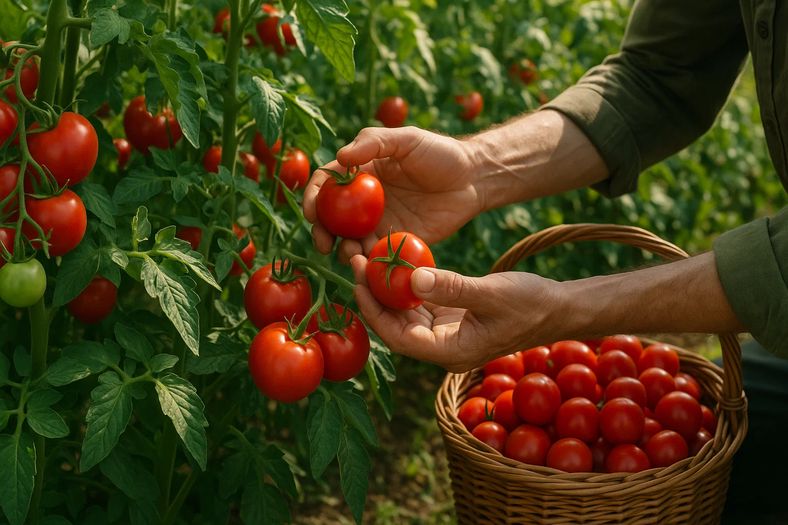
Tomatoes start ripening from mid-summer onwards, with timing depending on variety, weather conditions, and fruit size. Smaller cherry tomatoes ripen more quickly than larger fruits, and greenhouse plants usually start cropping earlier and continue longer into autumn.
Harvesting Tips
- Check plants every few days
- Pick tomatoes individually with stalk attached
- Harvest as soon as they're ripe and fully colored
- You can't beat the flavor and scent of freshly harvested tomatoes
End of Season
When the growing season ends and you have unripe fruit:
- Lift outdoor plants with unripe fruit and lay on straw under cloches
- Pick unripe fruits and place somewhere warm and dark to ripen
- Put unripe tomatoes in a drawer with a banana to aid ripening
Problems
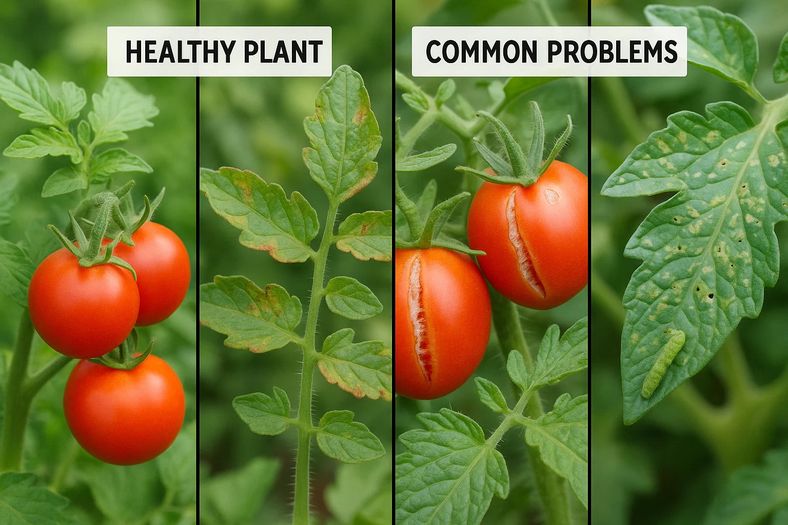
In a warm summer, tomatoes are easy to grow and will fruit readily if watered regularly. However, problems can occur when growing conditions aren't ideal, and plants can be affected by diseases and pests.
Common Issues
- Irregular watering: Can cause fruit splitting or blossom end rot
- Blight disease: More common outdoors than in greenhouses
- Sap-sucking insects: Various pests can affect plant health
- Poor pollination: Especially in closed greenhouse environments
Most problems are preventable with proper care, consistent watering, good ventilation, and choosing disease-resistant varieties where possible.